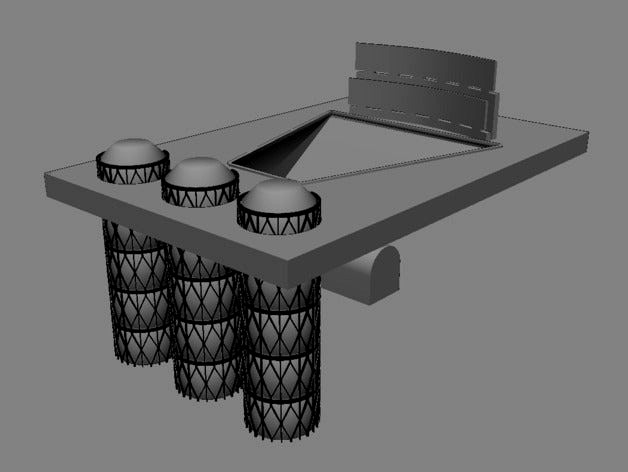Thingiverse

The First Mars Habitat by LocksRevenge
by Thingiverse
Last crawled date: 4 years, 4 months ago
The atmosphere of Mars is over 100 times thinner then that of Earth, which leaves the surface of the planet open to wide ranging temperature differences and radiation. This will affect building structures wear and tear as they expand and contract. Anything organic will also be subject to a higher amount of surface radiation, which includes both plant and animal.
Rather then shipping extra shielding from Earth, go underground.
The distance from the sun gives Mars roughly 40% of the sunlight that Earth gets. This is the equivalent to a cloudy day. To maximize the amount of light for power creation and to enable photosynthesis, reflectors would be used to direct and amplify the light.
The base would be built into the ground that slopes upward to where the mirrors are located at the peak of the slope. Behind those are sensors and communications satelite. At the base of the slope you would have the power generating unit that would be similar to molten salt being used to make steam that would then be used in turbines. Behind this is hydroponics. Next would be laboratories and office space. The next level would be living quarters and habitation.
Behind the power plant, hydrponics, laboratories and habitation area there is the waste processing. Hazardous material would possibly be incinerated if the contents can not be properly recycled or repurposed. Organic material would be composted. Grey water would be treated and cycled back in for general use.
Minimal external moving parts that would not be exposed to the elements of Mars. While the main base would be under several meters of Martian rock. The weight of the rock would allow for the pressure in the base to be adjustabled per zone without the danger of an implosion that could happen on the surface without the support structure to contain the pressure. The added rock also shields the base from harmful radiation from the cosmos and from the Sun.
Additional light can be provided by satellites in orbit that are geosynchronous. The satelite(s) would focus and magnify light to a specific area (Martian base).
Expansion could potentially be as simple as digging out a section in the rock, spraying the chamber with a sealant and pressurizing.
Rather then shipping extra shielding from Earth, go underground.
The distance from the sun gives Mars roughly 40% of the sunlight that Earth gets. This is the equivalent to a cloudy day. To maximize the amount of light for power creation and to enable photosynthesis, reflectors would be used to direct and amplify the light.
The base would be built into the ground that slopes upward to where the mirrors are located at the peak of the slope. Behind those are sensors and communications satelite. At the base of the slope you would have the power generating unit that would be similar to molten salt being used to make steam that would then be used in turbines. Behind this is hydroponics. Next would be laboratories and office space. The next level would be living quarters and habitation.
Behind the power plant, hydrponics, laboratories and habitation area there is the waste processing. Hazardous material would possibly be incinerated if the contents can not be properly recycled or repurposed. Organic material would be composted. Grey water would be treated and cycled back in for general use.
Minimal external moving parts that would not be exposed to the elements of Mars. While the main base would be under several meters of Martian rock. The weight of the rock would allow for the pressure in the base to be adjustabled per zone without the danger of an implosion that could happen on the surface without the support structure to contain the pressure. The added rock also shields the base from harmful radiation from the cosmos and from the Sun.
Additional light can be provided by satellites in orbit that are geosynchronous. The satelite(s) would focus and magnify light to a specific area (Martian base).
Expansion could potentially be as simple as digging out a section in the rock, spraying the chamber with a sealant and pressurizing.
